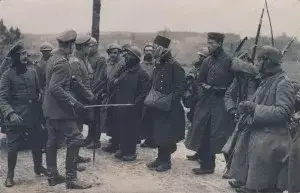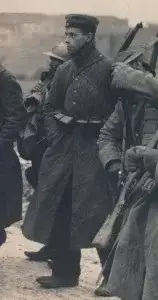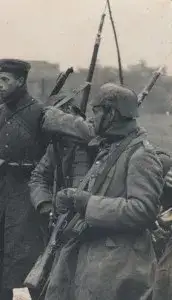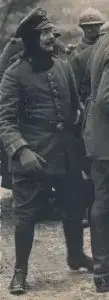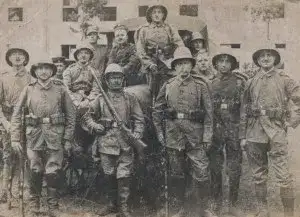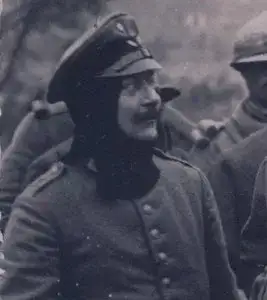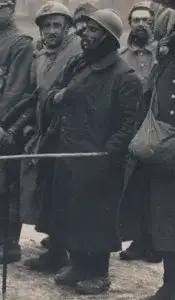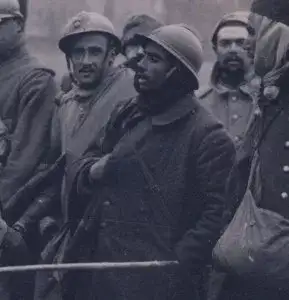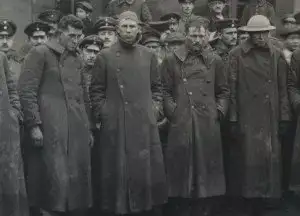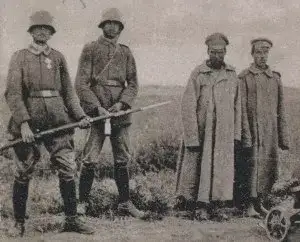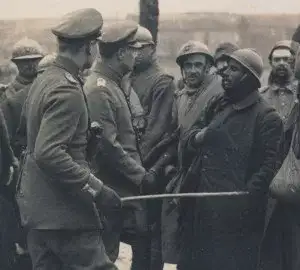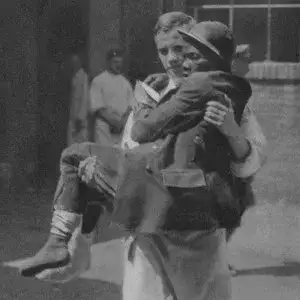A prisoner who refused
May 28, 2023 by Thomas Wictor
I once saw a World War I postcard that I wished desperately I had in my collection. Today my own original copy arrived. It shows a prisoner of war who refused to play by the rules. Here’s the image.
German officers are interrogating French prisoners of war. The uniforms of the Germans show that the Frenchmen were captured during a trench raid. Both sides went on raids to collect enemy soldiers. By taking prisoners you identified the unit opposite you, and maybe they would tell you about upcoming operations. Military intelligence was quite good at rating the effectiveness of individual units, so when you identified the division opposite you, then you could prepare.
If it was an attack division, you needed to shore up your defenses. If it was a garrison division full of older or physically infirm men, you didn’t worry.
The two men in the center of the photo, facing to the left, are Moroccan. Without question the best fighters in the French army were Moroccans and Senegalese. They were shock troops who spearheaded assaults. The rest of the French soldiers in the photo are regular line infantrymen.
This is a German trench raider.
He’s wearing a soft cap instead of a steel helmet, he’s armed with a carbine instead of a rifle, and he’s removed the shoulder straps from his overcoat. The soft cap allows for better visibility and hearing and won’t clank if the soldier bumps his head on a metal barbed-wire stanchion. A carbine—being shorter—is easier to use in a trench. To prevent identification if he’s captured or killed, the soldier has taken off his shoulder straps.
These next men likely waited in No Man’s Land, ready to provide supporting fire for the trench raiders.
They have rifles with fixed bayonets, and they carry cotton bandoliers of ammunition instead of the leather pouches normally seen. The bandoliers indicate that they lay on their bellies, aiming. Their helmets have their unit number on the front, so these men wouldn’t have entered the enemy trench.
This is a soldier from the Motor Transport Troops.
I think he’s faking. His uniform is that of a private, but he seems a bit mature and a tad too debonair. He may be the officer who led the trench raid; that would explain his balaclava.
During combat, officers on both sides wore the uniforms of enlisted men. This was to protect against snipers or other enemies who wanted to take out commanders of an operation.
Motor Transport Troops—drivers—often went on trench raids in order to collect information that infantrymen might overlook. They also knew how best to disable enemy vehicles, and in the German army they operated flamethrowers and tanks.
These are Motor Transport Troops of the Pascha II Expedition to the Middle East.
Trained as assault infantry, they fought in all the same places that people are fighting today. It’s a virtual certainty that all the men in that photo were killed in action.
Whoever this guy is—driver, trench raider, officer—he looks upset.
I think the reason he seems unnerved is this Moroccan prisoner.
Does this man look afraid, ashamed, or cowed?
Check out the face of the French prisoner next to the Moroccan. He seems to be bracing himself, thinking, Ohhhhhhhhh, jeez…
The Geneva Conventions prohibit showing off prisoners of war, but nobody adhered to that. These are the first Americans who the Germans captured in World War I.
They were taken by a Bavarian 200-man shock troop that attacked in the middle of the night, blew the hell out of the American position, killed dozens, and screamed at the survivors to get moving into No Man’s Land or die.
Russian prisoners of war with their gigantic German captors.
Being captured in combat is a deeply traumatic experience. But not for this man.
The German officers interrogating him would be speaking French; it’s not likely that a Moroccan enlisted man could speak German.
In the foreground is a lieutenant of a Guards regiment; the other officer is a captain. We therefore have two physically imposing officers of a culture notorious for its sense of superiority, questioning a small Arab man who was taken from his trench by force, and yet the Moroccan seems unfazed. His body language is relaxed, even though he stands perfectly straight, his head up.
When we look at the photo again, it’s clear that the Germans are far more tense than the Moroccan. It’s a magnificent tableau.
Are the Germans angry at this fearless soldier? Do they think he’s not showing them enough deference?
I’m sure he’s safe. In World War I there was still a nineteenth-century sense of chivalry among soldiers. Even if the Germans found the Moroccan prisoner’s attitude offensive, they wouldn’t have murdered him. It could be that the lieutenant in the foreground is ready to poke him with the walking stick. He may even have hit him, but I don’t think so.
My guess is that against their will, the Germans found themselves admiring this man for his courage. Germans abhorred the British and French use of colonial troops. Facing a non-Caucasian opponent was insulting. And yet here we see a German military surgeon carrying a wounded Senegalese soldier.
I see nothing negative in the surgeon’s face. His hands tell the story: He’s pained by the soldier’s suffering. It’s just another man he holds in his arms.
The Germans were terrified of French colonial soldiers, especially Moroccans and Senegalese, the best warriors in the conflict. At the same time, the Germans viewed colonial troops as savages.
Could it be that these preconceived notions faded away when the Germans met colonial troops face to face? Do these two images from almost a century ago have a message for us? Or am I engaging in wishful thinking?
Social media proves that a lot of people have some really moronic notions about “others.” I know that the majority of humans are a product of their culture, but I still view them as individuals. When I meet or see people from different cultures, I don’t make assumptions. I don’t start off by thinking, “This person is _______.”
I hope this Moroccan soldier made it home safely, and I hope he had a long and happy life.
He did things his own way. Good for him.
This article viewed 390 times.

